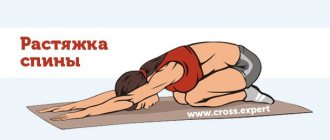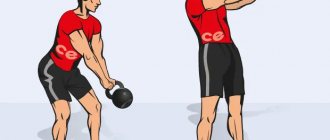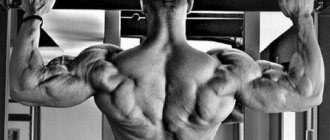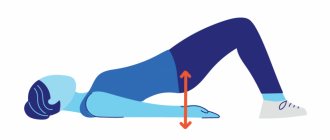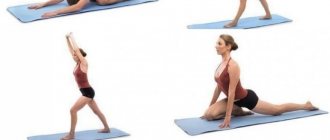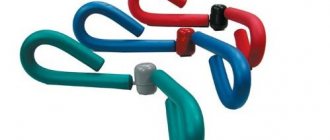Doing exercises with a back band is an effective way to strengthen and train your back muscles. In addition, training with this mini-simulator helps to avoid problems with the spine, which many people face in the modern rhythm of life.
The spine is the foundation of our body. The health of internal organs directly depends on its condition. Therefore, regularly exercising and developing your back muscles is vital. Training with an expander band is suitable for those who want to win the fight against excess weight, get rid of osteochondrosis, or just feel good.
What is an expander?
An expander is a rubber or spring sports equipment designed to work certain muscles by compressing or stretching it..
Benefits of an expander:
- can be used for home training: it is compact, lightweight and takes up little space;
- suitable for intensive training of small muscle groups (exercises with an expander are isolating);
- allows you to complicate any familiar exercises and increase the load;
- can be used by all people (children and adults, men and women);
- allows you to train different muscle groups;
- helps to tone all the muscles of the body, burn extra calories, and get beautiful relief.
The benefits of an expander for the musculoskeletal system
It is quite natural that most physical activities have contraindications and health restrictions. Therefore, the desire for a perfect body is often accompanied by dislocations, sprains and other injuries to the musculoskeletal system.
When exercising with an expander, you can use absolutely all the back muscles
However, exercises with an expander (with the right choice of load) only benefit the body. They :
- strengthen ligaments, improve joint mobility;
- stimulate blood circulation;
- prevent the development of joint diseases (including in elderly people);
- form correct posture;
- restore muscle activity during post-traumatic rehabilitation;
- burn calories, tone muscles;
- develop muscle strength and endurance, contribute to the formation of beautiful relief.
At what age can you start training?
You can exercise with an expander at any age . The training will benefit both children and the elderly. The main thing is that the equipment corresponds to the age category. So, elastic rubber expanders are more suitable for children and teenagers, and spring metal exercise equipment is more suitable for adults.
Principle of operation
Ski expanders (photo above) are classified as multifunctional exercise machines, since with their help the main and problematic muscle groups are worked out. You can exercise at home, in the office, on the street or in the gym - the choice is yours.
The principle of operation of the device is simple: elastic bands are compressed and stretched like a spring, and the resulting force is a load on the muscles. On modern models, latex versions are used instead of rubber elements. They are more durable and easier to use.
Indications for use
It is recommended to perform exercises with an expander:
- schoolchildren (to strengthen muscles and form correct posture);
- beginner athletes;
- people with poor health;
- patients who have recently suffered musculoskeletal injuries.
The main thing is to choose the load based on your own capabilities.
Contraindications
An expander is a simulator on which it is simply impossible to get injured, so there are practically no contraindications to its use. Everyone can do back exercises, except people with acute joint diseases .
Bubnovsky method
The expander is far from the last place in Dr. Bubnovsky’s exercise system.
Classes according to an individually developed program by a doctor allow you to get rid of many problems with the musculoskeletal system. Already a month later, the first positive results appear after such exercises:
- tilting the body with an expander band clamped under the feet;
- sitting, with it fixed on the wall (hands pull the handles to the hips as you exhale, straighten forward again as you inhale);
- some others.
By devoting just a few minutes a day to exercises with an expander, you can forget about discomfort and back pain. Do not forget that the key to the success of training of this kind is systematicity and regularity.
source
Types of expanders and how to choose the right projectile
Based on the type of load, equipment is divided into compression expanders and tension expanders . In the first case, the projectile must be compressed, and in the second, it must be stretched.
Types of expanders
When choosing an expander, you need to pay attention to what muscles it is intended to train. Some products allow you to train a specific muscle group, while others are multifunctional and are used to develop different muscle groups. The rigidity (degree of resistance) of the expander is measured in kilograms.
Today, the following types of expanders are distinguished::
- carpal;
- shoulder (chest);
- rubber (tubular);
- latex tape;
- skier's expander;
- "butterfly";
- multifunctional.
Depending on the material, expanders are rubber, metal and plastic . Metal projectiles are intended for professional athletes, rubber ones for amateurs (including children and teenagers). As for plastic expanders, they can be both amateur and professional. However, they have a significant drawback - fragility.
Often there are products with anatomical loops for legs or anatomical handles that follow the shape of the palm. The handles of the expander can be improved: have a massage effect or have ventilation holes.
When choosing the type and rigidity of the projectile, you need to start from what goal you are pursuing. Please note: the same muscle group can be trained using different expanders.
Your task is to choose the product that is right for you. To check how the projectile “behaves”, take it in your hands and do a few exercises. It is desirable that the resistance of the expander can be adjusted (this will allow you to gradually increase the load without risk to health).
Sports stores offer a wide selection of expanders: expensive and cheap, high quality and not so good. Experts recommend buying safe and reliable products from trusted manufacturers.
When choosing an expander, pay attention to its rigidity. Tips for choosing an expander:
- Choose the appropriate hardness . The equipment must match your build, level of training, and goals. Professional expanders can have a resistance of more than 50 and 100 kg, and the stiffness of amateur expanders rarely exceeds 25 kg. Information about the hardness of the product must be indicated on the label. You can also pay attention to the color of the projectile: yellow – low hardness, green – higher, red – medium, blue – high.
- Inspect the product before purchasing . When choosing an expander, pay attention to the quality of the material. There should be no defects or malfunctions on the surface of the apparatus that could reduce the quality of the exercises or cause injuries.
Video: “Horizontal elastic band pull”
For biceps
Arm curls with an expander
I think everyone knows that the most common exercise for biceps is the BELL BAR CURL. So we will do something similar only with an expander. There is an opinion that a change in the position of the hands relative to each other. May change the tension on each biceps head. A narrow arrangement puts more stress on the long head, and a wide one on the short one. But you won't feel much of a difference. Therefore, this moment can be used to diversify the exercise.
Performance:
- Stand on the middle of the expander with your feet.
- Take its ends in your hands.
- Lean forward slightly and bend your knees. This will make your position more stable.
- Press your elbows close to your body.
- As you exhale, bend your arms by contracting your biceps.
- We take a short pause in the upper position and slowly straighten our arms.
Do not lift your elbows up when bending your arms. Perform the exercise only by contracting your biceps. Don't swing or use your leg muscles.
Reverse grip curls
To fully develop the arm muscles, you need to train another muscle. We are talking about brachialis. It is located under the biceps and is responsible for the same function, bending the arm at the elbow. A reverse grip (pronated) allows us to exclude the biceps muscle from the exercise, so we can load the brachialis more heavily.
Performance:
- To perform reverse curls, it is best to use an expander with handles.
- The starting position is the same as in the previous version.
- We stand in the middle of the expander and take its edges in our hands with a pronated grip.
- As you exhale, bend your arms at the elbow.
- We take a short pause, and while inhaling, we straighten them.
Do not bend your arms while doing this. Watch the position of your elbows. They should not extend forward or backward relative to the body.
General rules of use
Did you know that...
Next fact
Basic rules for using an expander:
- Exercises with an expander belong to the category of strength exercises, and to grow and strengthen muscles you should not perform many repetitions (multiple repetitions of exercises are appropriate for cardio training). The optimal number of repetitions in one approach varies from 12 to 15. If you feel that the exercises are becoming too easy, you can increase the rigidity of the apparatus (add resistance).
- Before any strength loads (including training with an expander), you need to do a warm-up. During it, you should warm up those muscle groups that will be worked out during the main part of the lesson. Every workout should end with stretching. It will prevent lactic acid stagnation and help avoid discomfort the next day after training.
- Exercises with an expander should be performed smoothly. The appearance of pain during exercise indicates the presence of health problems or that you are doing something wrong.
- When performing an effort, you need to “hang” in this position for a few seconds, and only then return to the starting position.
- Before you start training, you need to make sure that the expander is firmly attached to the wall or horizontal bar and is not damaged. The presence of microcracks, problems with fastening - all this can cause the cord to break at the most inopportune moment and lead to injury.
- It is advisable to exercise with an expander in shoes. If you catch a dense projectile on an unprotected foot, you can get calluses and cramps.
There are other exercise machines and sports equipment for strengthening the back, which you can familiarize yourself with in the following articles:
- Contraindications and features of training on exercise machines for the back and spine
- Exercises and tips for proper exercise on a fitness ball on the page
- You can read about the technique of doing back exercises at home with dumbbells here
Rubber band for weight loss
During exercises with a rubber band, excess calories are intensively burned, which promotes weight loss.
One of the options for a set of exercises with a rubber band for weight loss for women
If you choose exercises with a band as the main way to lose weight, then you must adhere to the following principles:
- It is recommended to complicate the exercises gradually, monitoring the body’s reaction to increased load.
- You need to breathe properly during training.
- You should definitely do a warm-up and cool-down after training (you can run in place or jump rope as a warm-up).
Exercises with a rubber band are performed not only for weight loss. A set of workouts with this equipment for women is an opportunity to tone the body, strengthen muscles, add definition to them, and develop flexibility without the use of exercise equipment.
Article design: Svetlana Ovsyanikova
A set of exercises for the back with an expander, technique for men and women
Below are the most popular and effective exercises for men and women:
- Rowing to the waist while sitting. Starting position: sit on the floor, bring your legs together, straighten your knees and place them in front of you. Throw the expander over your feet and take the edges of the cord in your hands. As you inhale, straighten your back, move your elbows and shoulders back, trying to connect your shoulder blades. At the exit, return to the starting position. To feel all the back muscles without exception, you need to perform two or three sets of 12-15 repetitions. Rest between sets – 30 or 40 seconds.
- Standing back row. Starting position: stand up, place your feet shoulder-width apart, throw the ribbon over the horizontal bar, straighten your back, secure the ends of the cord in your hands. As you inhale, pull your elbows back, squeeze your shoulder blades together and move your pelvis back. Hold this position for 2-3 seconds. As you exhale, return to the original position.
- Bringing your hands together in front of you. Stand up, lean on your feet, place your legs exactly under your shoulders, straighten your back, tuck your pelvis forward, throw the elastic band over your back, and place its ends in your hands, with your arms lowered along the body and relaxed. As you inhale, forcefully bring your hands straight in front of you. If the length of the expander and your physical capabilities allow, try not just to stretch it out, but to cross your arms in front of you (this will increase the load significantly). Exhale and slowly return to the starting state.
- Raising your arms on a chair. Sit on a chair, rest your feet on the floor, straighten your back, throw the band over the seat of the chair, and take the ends of the expander in your hands. Taking a deep breath, pull the ends of the expander upward (to the level of the forehead or above), without straightening your elbows. Fix the load. As you exhale, return your hands to the starting position.
- Lunge arm stretch. Starting position: stand up, throw the expander over the horizontal bar, place your hands in front of you, hold both ends of the cord in your palms. Make a slight lunge forward with your right leg, also lean your body forward slightly, straighten your back, maintain a deflection, do not slouch. During the lunge, inhale and straighten your arms up. As you exhale, return to the starting point.
Pay attention to the technique of performing exercises with an expander
Exercises with an expander should be performed 10-12 times . After completing the exercises, rest and then do one or two more approaches.
You can also do Dr. Bubnovsky’s gymnastics with an expander . You can get acquainted with the list of exercises and the technique of performing them from your doctor.
Video: “Exercises for the back muscles with an expander”
For the back
Bent over expander row
Let's start with basic exercises aimed at developing back thickness. It is an analogue of the BAR ROLL IN THE INCLINE. Depending on the angle of inclination, we can shift the load from the top to the bottom of the latissimus muscles. Due to the fact that we perform rows with both hands, we can take more rigid expanders. This will increase the load on the working muscles. As a result, they will begin to grow.
Performance:
- Stand with both feet in the middle of the expander and take its edges in your hands.
- We move the pelvis back and tilt the body forward. For greater stability, bend your knees slightly.
- The back should be straight, there should be a slight arch in the lower back, and the gaze should be directed forward.
- As you exhale, we begin to bring the shoulder blades together and pull the edges of the expander to the lower abdomen (the area under the navel).
- Hold this position for a short time to maximize the load on the latissimus and rhomboid back muscles.
- Then, as you exhale, we return to the starting position.
Perform deadlifts by contracting your back muscles rather than bending your arm. To do this, focus on squeezing your shoulder blades together and lifting your elbows up. Take your time, do the exercise at an average pace. If you have done this deadlift before, only with a barbell. Then at first, performing it with an expander will not be familiar. But this is a temporary effect and it will pass quickly.
Vertical thrust
And again, a basic exercise for training your back. Basically, VERTICAL PULLING is performed in a crossover. It is aimed at increasing the width of the back. To complete it, we will need to secure the expander to something. I have already written about this earlier. We can also work on different areas of the back and increase the range of motion. This is achieved by positioning the edges of the expander relative to each other. The closer they are, the greater the amplitude will become and the load will fall on the bottom of the lats. A wide stance uses the upper part of the lats. But this will reduce the amplitude.
Performance:
- Secure the middle part of the expander to the bracket installed at the top. Or press it against the door (assuming your doors are secure).
- Grab its edges with your hands and kneel down.
- As you exhale, pull the edges of the expander down.
- As you inhale, return to the starting position.
Beginners will find it difficult to feel the work of their back at first. But there is a proven method. You need to focus on lowering your elbows rather than bending your arm at the elbow joint. And then the biceps will not dominate the exercise.
Horizontal thrust
Another exercise option for the back that helps develop its thickness. It is performed while sitting on the floor. It is analogous to the LOWER BLOCK ROD. As in the vertical row, we also increase the amplitude of movement by bringing the edges of the expander together. A kind of close grip deadlift.
Performance:
- Sit on the floor. Extend your legs forward.
- Take the expander by the edges and secure the middle to your feet.
- Straighten your back, lean your chest forward a little. Arch your lower back.
- As you exhale, pull the edges of the expander towards the middle of your abdomen. To perform the movement, you need to bring your shoulder blades together.
- While inhaling, we return to the starting position.
Before you start, check that the expander is securely fastened to your feet. To be calmer, you can rest them against the wall. This is very important, as the expander can come off in your face. Watch your movements. Do not bend your legs or round your back while doing this.
